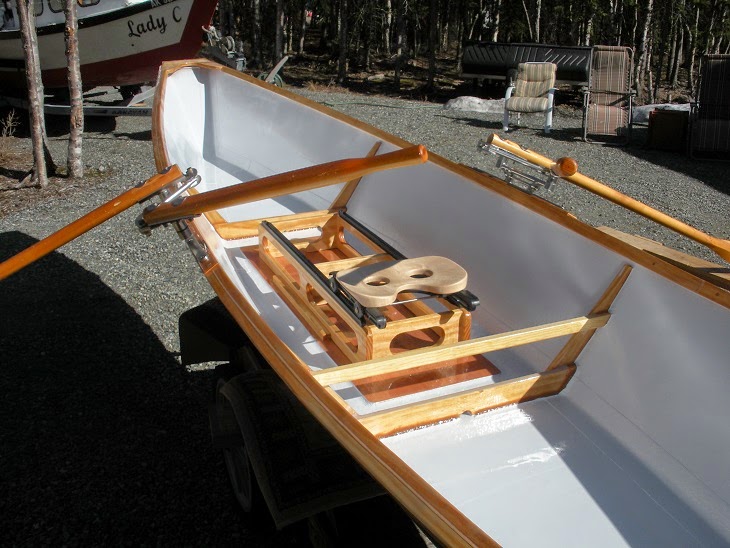Pulling Stitches
After the inside joints have cured, I turned her over and pulled her stitches.
 |
| 16 gauge steel wires in the Nemah stem |
With larger boats using 16 gauge wire stitches, like the Nemah and Lacy C, before installing the stitches I coat them with wax. Epoxy doesn't stick to wax and the stitches can be pulled after the epoxy cures.
 |
| Heating and pulling copper wire stitches |
With copper wire, no wax is needed. You can heat the copper wire and pull it out. I apply heat with a propane touch. When the copper wire discoloration reaches the wood surface, the end of the wire is usually red hot. I grip the wire with pliers and it pulls out easily. I toss the hot wire in the soda can so it cools before throwing it in the trash.
The challenge is to not burn the house down.
Sanding the Exterior Joints
 |
| Rounding the chines |
With the stitches gone, the exterior of the chines, stem and transom can be sanded flush and rounded. The
RevolutionPly surface veneer is so thin that if I knick it with the sander, I will expose the butt-ugly glue layer beneath. This is where pre-coating the RevolutionPly with fiberglass and epoxy comes in handy. The fiberglass and epoxy provide a protective layer so that when I knick the RevolutionPly with the sander, no harm is done.
 |
| Chines |
 |
| Transom |
Taping the Exterior Joints
 |
| First layer of tape on the transom |
I decided to use two layers of 9-ounce fiberglass tape. I apply it using the dry method, allowing the first layer to fully cure before applying the second layer.
 |
| Transom fiberglass layers sanded and ready for final coating |
After the second layer of tape has cured, I sand the tape layers for the final epoxy coat.
Because the
West System 105 resin with 207 hardener run badly, I mask the area outside of the coating, The runs stay on the masking and off of the boat.
About 90 minutes after the completing the final coat of epoxy, the epoxy is cured enough to be done running. That is when I remove the masking. The epoxy is far from being fully cured and the masking comes off easy. If I wait until the epoxy is fully cured, the masking is glued to the boat and it is very difficult to remove the masking.
 |
| Completed transom |
 |
| Stem ready for first coat of fiberglass and epoxy |
 |
| Stem fiberglass layers sanded and ready for final coat of epoxy |
 |
Completed stem. Notice the blemish where I burned the
epoxy using the torch to heat the stitches |
 |
| Chine masked for taping |
 |
| Applying the first layer of tape |
 |
This is a good time to coat the bottom and
exterior of the wubwail. All excess epoxy gets brushed
onto the wubwail |
 |
| Applying the second layer of tape |
 |
| Sanding the tape layers in preparation for the final epoxy coat |
 |
| Final coat of epoxy on the chines |
That Damned Skeg
 |
| Butt-ugly skeg #2 |
In my
Bad Hair Day post I lamented about my challenges with the skeg. I finally got the second skeg completed and was about to mount it on the boat when I realized how ugly it was.
The second skeg is in the trash and I built a third skeg.
 |
| Laminating the 3rd skeg |
This time I laminated RevolutionPly surface layers to a core of 3/8 marine plywood.
 |
| RevolutionPly surface over maring plywood core |
 |
| Applying fiberglass tape to skeg edges |
After cuting the skeg to shape and rounding the edges, I coated the edges with 2 layers of fiberglass tape.
 |
| Bead of thickened epoxy for gluing the skeg |
Then I glued the skeg to the bottom of the Sea Scull.
 |
| Skeg installed without epoxy fillets |
 |
| Final skeg with epoxy fillets |
That is much nicer than skegs 1 and 2. The third time is a charm.
Yes, that is quite a lovely bottom.












































































